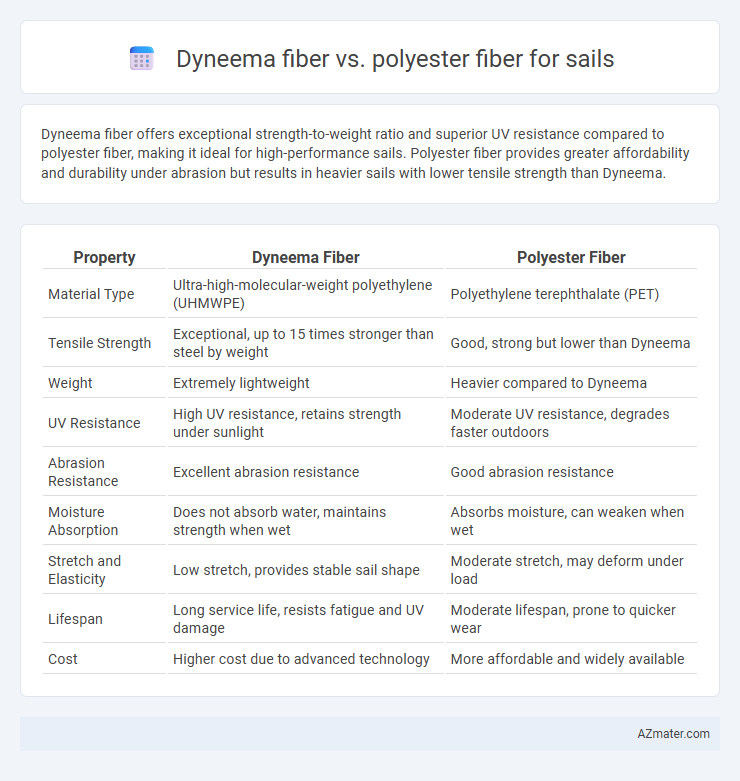Dyneema fiber offers exceptional strength-to-weight ratio and superior UV resistance compared to polyester fiber, making it ideal for high-performance sails. Polyester fiber provides greater affordability and durability under abrasion but results in heavier sails with lower tensile strength than Dyneema.
Table of Comparison
| Property | Dyneema Fiber | Polyester Fiber |
|---|---|---|
| Material Type | Ultra-high-molecular-weight polyethylene (UHMWPE) | Polyethylene terephthalate (PET) |
| Tensile Strength | Exceptional, up to 15 times stronger than steel by weight | Good, strong but lower than Dyneema |
| Weight | Extremely lightweight | Heavier compared to Dyneema |
| UV Resistance | High UV resistance, retains strength under sunlight | Moderate UV resistance, degrades faster outdoors |
| Abrasion Resistance | Excellent abrasion resistance | Good abrasion resistance |
| Moisture Absorption | Does not absorb water, maintains strength when wet | Absorbs moisture, can weaken when wet |
| Stretch and Elasticity | Low stretch, provides stable sail shape | Moderate stretch, may deform under load |
| Lifespan | Long service life, resists fatigue and UV damage | Moderate lifespan, prone to quicker wear |
| Cost | Higher cost due to advanced technology | More affordable and widely available |
Introduction to Sailmaking Fibers
Dyneema fiber offers exceptional strength-to-weight ratio and high resistance to UV damage, making it ideal for sailmaking applications where durability and performance are critical. Polyester fiber provides good dimensional stability and excellent stretch resistance, ensuring reliable shape retention in sails under load. Both fibers are widely used in modern sailmaking, with Dyneema favored for high-performance racing sails and polyester common in cruising sails due to its balance of cost and durability.
Overview of Dyneema Fiber
Dyneema fiber, known as ultra-high-molecular-weight polyethylene (UHMWPE), offers exceptional strength-to-weight ratio, making it highly suitable for high-performance sails. It exhibits superior resistance to UV degradation, moisture, and abrasion compared to traditional polyester fibers, ensuring longer sail durability and consistent performance. This synthetic fiber's low stretch properties enhance sail shape retention and improve overall sailing efficiency.
Overview of Polyester Fiber
Polyester fiber, widely used in sailmaking, offers excellent UV resistance, durability, and cost-effectiveness compared to Dyneema fiber. Its high tensile strength and minimal stretch under load make it suitable for performance cruising and racing sails. Polyester fibers maintain shape retention and resist moisture absorption, ensuring reliable sail performance in diverse marine environments.
Strength and Durability Comparison
Dyneema fiber offers exceptional tensile strength, outperforming polyester by up to fifteen times while maintaining lightweight properties crucial for sail performance. Its superior durability includes outstanding resistance to UV degradation, moisture, and chemical exposure, ensuring longer sail lifespan under harsh marine conditions. Polyester fiber remains valued for cost-effectiveness and moderate strength, but Dyneema's advanced fiber technology dominates in high-performance sail applications requiring maximum strength and durability.
Weight and Flexibility Differences
Dyneema fiber is significantly lighter than polyester fiber, offering a higher strength-to-weight ratio that improves sail performance by reducing overall weight. Its exceptional flexibility allows for better shape retention and resistance to fatigue under dynamic loads, unlike the stiffer polyester. These properties make Dyneema an ideal choice for high-performance sailing applications where weight savings and durability are critical.
UV and Weather Resistance
Dyneema fiber exhibits superior UV resistance and weather durability compared to polyester fiber, making it highly suitable for sails exposed to prolonged sunlight and harsh marine environments. Its molecular structure provides exceptional resistance to UV degradation, maintaining tensile strength and flexibility over time. Polyester fiber, while durable and cost-effective, degrades faster under UV exposure and harsh weather conditions, often requiring more frequent maintenance or replacement in marine applications.
Stretch and Shape Retention
Dyneema fiber offers superior stretch resistance compared to polyester fiber, maintaining sail shape under heavy loads and enhancing overall performance. Polyester fibers exhibit higher stretch rates, which can lead to sail deformation and reduced aerodynamic efficiency over time. The exceptional dimensional stability of Dyneema results in better shape retention, making it a preferred choice for high-performance sailing applications.
Cost Analysis: Dyneema vs Polyester
Dyneema fiber offers superior strength-to-weight ratio and durability compared to polyester but comes at a significantly higher initial cost, often 3 to 5 times more expensive per yard. Polyester remains a cost-effective option for sails with moderate performance requirements, providing acceptable longevity at a fraction of Dyneema's price. When evaluating total lifecycle costs, Dyneema's resilience can reduce replacement frequency, potentially offsetting its upfront expense over time.
Performance in Different Sailing Conditions
Dyneema fiber offers superior strength-to-weight ratio and exceptional UV resistance, making it highly durable and reliable in harsh sailing conditions such as strong winds and rough seas. Polyester fiber provides good abrasion resistance and stretch control, performing well in moderate to light wind conditions but tends to absorb water, increasing weight and reducing efficiency. Sailors often prefer Dyneema for high-performance racing sails due to lower stretch and improved shape retention, while polyester remains a cost-effective choice for cruising sails in variable conditions.
Choosing the Right Fiber for Your Sail
Dyneema fiber offers superior strength-to-weight ratio and exceptional UV resistance, making it ideal for high-performance sails requiring durability and minimal stretch. Polyester fiber provides greater abrasion resistance and affordability, suited for cruising sails where cost and toughness against wear are priorities. Selecting the right fiber depends on balancing performance needs with budget constraints and environmental exposure, ensuring optimal sail longevity and handling characteristics.

Infographic: Dyneema fiber vs Polyester fiber for Sail
 azmater.com
azmater.com